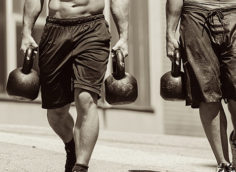In any competitive industry, there comes a time when ideas are scarce
and it seems like there's nothing left to "invent." One common way around
this phenomenon is to add variations to the things that already work,
but are becoming tiresome and overdone.
Another way of breaking through stagnant programming, or concepts in
need of change, is to bring old methods back from the dead and breathe
new life into them through modern application.
 |
It's like reinventing the wheel... only it's
actually useful.
This is especially true in the strength and conditioning industry, where
new methods of training, movements, exercises, and even lifting devices
are constantly being modified, reinvented, and reintroduced to become
the latest fad... again.
Every coach out there has a few things they cannot live without. Even
as methods, tools, and other concepts of one's training change, there
always seems to be a place for those few favorites.
As a strength coach that primarily works with athletes, Olympic-style
weightlifting has been a mainstay in my program for many years now. Just
take a look at the sprinting speed and jumping ability of any top Olympic
weightlifter, and you'll see why.
By using exercises like the power snatch and hang clean, athletes can
build the total body strength and power necessary to excel in sports.
The traditional method of Olympic lifting has never really disappointed
me, but like I mentioned above, there's always room for growth
and improvement.
For a long time, I played around with creating complexes and combinations
in order to satisfy my need for "new," but after a while, I decided to
look back to the old days for some inspiration.
History of the Split
Back in the 1960s, Olympic weightlifters used a lifting technique called
the split style. The lifter would use a split or lunge position to catch
the weight after the initial pull from the floor. These lifts were both
stylish and graceful to observe.
 |
Unfortunately, they fell out of favor over the last 40 years, and squat
fever spread like wildfire. More weight is alwaysthe goal in competitive
lifting, and the squat style allowed lifters to do just that, due to
an increased leverage and control over the weight.
Today, just about all top level lifters use the squat style in competition.
Although the split has been abandoned by the Olympic weightlifting community,
the lifts still offer some real benefits for athletic development.
As strength coaches, we're not preparing our athletes for Olympic lifting
competitions (except for those who work with actual Olympic weightlifters),
so maximizing loads should be a secondary concern. At our facility, we
use several variations of the Olympic lifts to help develop certain strength
qualities that will enhance sport performance.
Why Split Now?
When performed correctly, and used in conjunction with a well-rounded
athletic development program, the split lifts can be a valuable addition
to any strength and conditioning program.
As history has demonstrated, the Olympic lifts are excellent tools for
developing total-body strength and power through the explosive triple
extension of the ankles, knees, and hips required during the pulling
phases of each lift.
 |
Split-stance lifts differ from their squat-stance counterparts in that,
after completion of the pull, the athlete will move into the split catch
position. Achieving this position requires the athlete to quickly drive
one leg forward and the other leg rearward into a lunge or deep split-squat.
A number of key factors contribute to the proper execution of this catching
style. For example, the splitting of the legs after the pull must happen
extremely fast in order to successfully perform a split snatch or a split
clean.
The athlete must possess split-second timing, foot quickness, speed,
and dynamic lateral balance – all of which are components of agility
and translate directly to the field or playing arena. Take a look at
these videos to see what I mean.
<!--
| AC_FL_RunContent( 'codebase','http://download.macromedia.com/pub/shockwave/cabs/flash/swflash.cab#version=7,0,0,0','width','320','height','240','id','FLVPlayer8','src','/FLVPlayer_Progressive','flashvars','&MM_ComponentVersion=1&skinName=/Clear_Skin_2&streamName=/img/photos/2008/08-048-training/SplitCleanBarbell.wmv&autoPlay=false&autoRewind=true','quality','high','scale','noscale','name','FLVPlayer','salign','lt','pluginspage','http://www.adobe.com/shockwave/download/download.cgi?P1_Prod_Version=ShockwaveFlash','movie','/FLVPlayer_Progressive' ); //end AC code |
| AC_FL_RunContent( 'codebase','http://download.macromedia.com/pub/shockwave/cabs/flash/swflash.cab#version=7,0,0,0','width','320','height','240','id','FLVPlayer','src','/FLVPlayer_Progressive','flashvars','&MM_ComponentVersion=1&skinName=/Clear_Skin_2&streamName=/img/photos/2008/08-048-training/SplitSnatchBarbell.wmv&autoPlay=false&autoRewind=true','quality','high','scale','noscale','name','FLVPlayer','salign','lt','pluginspage','http://www.adobe.com/shockwave/download/download.cgi?P1_Prod_Version=ShockwaveFlash','movie','/FLVPlayer_Progressive' ); //end AC code |
| AC_FL_RunContent( 'codebase','http://download.macromedia.com/pub/shockwave/cabs/flash/swflash.cab#version=7,0,0,0','width','320','height','240','id','FLVPlayer2','src','/FLVPlayer_Progressive','flashvars','&MM_ComponentVersion=1&skinName=/Clear_Skin_2&streamName=/img/photos/2008/08-048-training/SplitSnatchDB.wmv&autoPlay=false&autoRewind=true','quality','high','scale','noscale','name','FLVPlayer','salign','lt','pluginspage','http://www.adobe.com/shockwave/download/download.cgi?P1_Prod_Version=ShockwaveFlash','movie','/FLVPlayer_Progressive' ); //end AC code |
-->
Split stance lifts not only demand a level of flexibility-strength,
but they also help to promote it, especially in the hip flexors of the
back leg. This extreme position necessitates that these muscles be both
flexible and strong in the fully stretched position in order to
provide enough stability to properly execute the movement.
Many of today's athletes often have tight hip flexors due to inactivity
and poor exercise choices. Tight hips can lead to injury and decreased
efficiency of movements such as sprinting and jumping. By utilizing exercises
like the split snatch, split snatch balance, and overhead split squat,
the athlete can kill two birds with one stone by strengthening the hip
musculature and promoting mobility of the hips as well.
Incorporating the Split Stance
The split lifts are fairly easy to learn, provided that an athlete already
has a decent foundation with the traditional power or hang clean and
snatch movements. It actually functions as a training tool for some tight-hipped
athletes. If one can't perform a proper power catch or squat catch, the
athlete will usually have an easier time catching in a modified (less
deep) split position.
A true split position would require an athlete's hips to be level with,
or slightly below, the forward knee joint at the bottom position of the
lift. When first learning the movements, it isn'tan absolute necessity
that the athletes go this low. Instead, an emphasis should be made on
achieving an adequate split-stance, with the hip of the trail leg fully
extended and front foot flat on the floor.
 |
While first attempting to become accustomed to the split-stance catch,
be sure to split both legs in the opposing directions. Many novices will
tend to only move the trail leg, failing to also step forward with the
lead leg. This results in an inadequate split, reduces the ability to
properly stabilize the movement, and increases the potential for injury.
The ultimate goal is to be able to perform the split catch with either
the right or left leg serving as the forward leg. When performing
a split catch, many athletes will instinctively lead with their dominant
leg on each and every repetition, as this will naturally be more comfortable.
Because of this, an individual must make a conscious effort to train
with each leg going forward equally. Doing this will help address any
imbalances between limbs that may exist, and will also help to prevent
any new imbalances from developing.
Summary
I encourage any athlete who already has sound technique in the power
clean and snatch to give these split-lift variations a try. They can
be challenging, fun, and serve as a nice change of pace from the traditional
style of the explosive lifts. And to all the coaches out there, the split
style gives us an additional way to increase athleticism in those we
train.
By now, if you're not aching to get out there and give these split-lift
variations a try, then I don't know what it will take to convince you.
This technique could be just what you need to bust through any barriers
holding you back, and continue along the path to athletic excellence.
One last time, let's review the benefits of the split style:
Allows less-flexible athletes, and those who struggle with proper squat
mechanics, to safely experience the benefits of Olympic lifting.
Develops flexibility-strength in the often-tight hip flexors.
Improves single-leg strength and stability, especially with the lead
leg.
Requires a higher pull, thereby promoting greater power output during
each lift.
Develops the components of agility – foot
speed, timing, total body coordination, and lateral balance.
Places greater demands on core stabilizers than traditional Olympic
lifts.
Provides a lifter with a new and challenging technique that can be both
fun to perform and easy to learn, once a basic foundation has been established
with the traditional Olympic lifts.
Special thanks to Shane Davenport and Mike Craven for their help with
this article.





